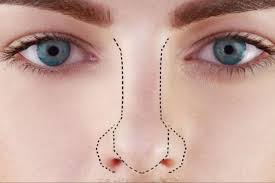Rhinoplasty

Everything about rhinoplasty surgery and frequently asked questions about this surgery
If you are looking for nose surgery, you need to pay attention to some important points in this regard. By reading this article, you can get more information about this nose job, its costs, risks and possible benefits.
Regardless of the type of rhinoplasty a patient needs, the doctor will use one or two of the following basic techniques to correct the problem:
. Closed Rhinoplasty: This surgical technique is usually superior to other techniques because all the slits are made inside the nose and there is no need to make a slit in the external area of the nose. In this case, even though the slits are hidden, the surgeon can access most parts of the nose and correct many of its aesthetic and structural problems.
. Open rhinoplasty: Open rhinoplasty gives the surgeon better access to the cartilage and bone of the nose, but with this procedure, some scarring remains on the patient’s nose. In this case, by creating a gap at the end of the middle nasal septum (the area between the two nasal cavities), the doctor can remove the skin of the nose and repair its cartilage. After healing, very limited marks remain on the skin from the gap created, which are mostly hidden under the nose area.
Choosing the right technique
Both open and closed rhinoplasty techniques can bring very satisfactory results for the patient. In this regard, the doctor can determine the appropriate technique for each patient according to the natural appearance of the nose and the goals of the surgery

The types of plastic nose surgeries that are performed on patients are as follows:
Correcting the shape of the tip of the nose: The tip of the nose is located exactly at the end of the nose, and in some people, one side of the nose is different from the other side. For example, one side of the nose can be bigger, smaller, higher, lower or slightly deviated from the other side. However, the surgeon can create a symmetrical appearance for both sides by manipulating the condition of the cartilage under the nose.
Correction of nasal deviation: nasal deviation occurs when the bones or septum of the nose are not located in a quarter of the middle line of the face. As a result of these conditions, the patient’s nose will appear to be drawn to one side. Most of the time, nasal deviation is a hereditary problem, although the condition can also develop as a result of an injury. However, by manipulating the bones and nasal septum, surgery can permanently smooth its appearance and eliminate the deviation of the nose.
Sunken nose: Sometimes the nose of some people has a depression on the bridge of the nose, which is called a sunken nose problem. Usually, this problem is treated by manipulating the nasal cartilage or using an implant or prosthesis. The results of this treatment can give a person a smooth, flat and uniform nose in the bridge of the nose.
image
Nasal nose surgeon: Some people feel that the appearance of their nose is suitable from the front and it may even be suitable from the side, but what these people are dissatisfied with is the thickness and bulkiness of their nose, and that is why these people They tend to thin their noses. However, if a person’s nose is wide due to the underlying bone structure, the plastic surgeon can usually make a significant reduction in the width of the patient’s nose and thus correct the appearance of the nose according to the person’s wishes.
Nose reduction: If your nose is clearly too big for your face, rhinoplasty can be used to reduce the size of your nose. Most large noses have a bony structure that can easily be changed.
Small nose: Not everyone wants to have a smaller nose. For example, if a person’s nose has been damaged due to an accident and the bridge over it has been destroyed, or if the person’s nose is normally small, rhinoplasty surgery can be used to increase the size of the nose and produce the desired results. To raise the bridge of the nose, the plastic surgeon uses one of the following two methods:
The first method involves taking cartilage from the nose, ears or ribs and using it to change the shape of the nose.
In the second method, implants or prostheses made of silicone or other bone-like materials are used to create changes in the appearance of the patient’s nose.
Fixing the hump of the nose: The bump or hump of the nose can be caused by an injury or due to genetic issues, but genetic issues are the most common cause of the hump of the nose. A hump can be caused by all types of noses. But if you have special problems in this regard, the surgeon can simply correct the hump of your nose by manipulating the cartilage under the bridge of the nose and straighten the appearance of your nose.
Big nose tip: A big nose tip usually has a bulbous appearance and makes the tip of the nose look rounder than normal or fat. The surgeon can change the cartilage under it by manipulating the tip of the nose and modify its appearance.@dr.mostafahosseini


Advantages
The rhinoplasty method has certain advantages as follows:
Creating symmetry between facial parts: limited imbalance in the nose area can cause significant defects in a person’s appearance. In this way, rhinoplasty can create a balanced appearance for the patient.
Improving appearance: changing the shape of the bridge of the nose or its head can attract people’s attention to other parts of the face.
Appropriate size: reducing the width of the nose even by a small amount can have a significant effect on the fit of the nose with the rest of the person’s face.
Removing the hump or correcting the nasal deviation: Regardless of whether the hump is caused by hereditary factors or due to an injury, rhinoplasty can correct defects on the bridge of the nose.
In addition to cosmetic benefits, rhinoplasty can also correct health-related problems. The two main advantages of this method for correcting the function of the nose are as follows:
Improvement of respiratory problems: rhinoplasty can open narrow nasal passages and correct its structural problems. In this way, this surgery can help improve breathing problems.
Correcting cases of congenital defects: rhinoplasty can correct external problems as well as internal congenital problems of the nose such as deviation of the nasal septum.
When rhinoplasty is used to correct structural problems, insurance providers may cover the cost.
Temporary side effects after surgery
Although long-term side effects are rare in this surgery, rhinoplasty can have some temporary side effects for a person as follows:
Bruising: Bruising usually occurs in the areas around the eyes and disappears after 10 days of surgery.
Discomfort: Patients may experience some discomfort and inflammation, especially in the reshaped areas of the nose or tissue removed for bone grafting. In most cases, sick people can relieve their discomfort by taking available painkillers.
Swelling: Most of the swelling caused after surgery usually disappears after a few weeks. However, it takes six months to a year to fully resolve this condition.
Side effects of anesthesia: Some people may experience nausea after using anesthesia, and this problem can be accompanied by temporary changes in voice and excessive secretion of mucous fluid.
Nosebleeds: Having nosebleeds for 72 hours after surgery is normal. Although the possible bleeding after this period is usually not serious, the patient should inform his surgeon about his nosebleeds if he observes these conditions.

dangers
When this surgery is performed by an experienced plastic surgeon, it can be a safe procedure with limited long-term side effects for the patient. However, all surgeries have certain levels of risk and danger. For this reason, it is necessary for the patient to be aware of these risks and to control his recovery process according to the surgeon’s care instructions. If any abnormal symptoms are observed in the patient’s condition during the recovery period, it is necessary to meet with the attending physician in this regard.
Potential side effects
The risks of rhinoplasty, despite being rare, are as follows:
. infection
. Allergic reaction to anesthetics
. Adverse cosmetic results include nasal asymmetry
. Remaining undesirable scars after surgery
.numb
. Respiratory problems
. Chronic nosebleeds
. Nasal septum perforation
Hematoma (accumulation of blood under the skin)
. Cut off blood vessels
. The possibility of having corrective surgery
Cost and price
Because rhinoplasty is different for each patient, the cost of rhinoplasty is not the same and depends on many factors. In this way, patients should discuss the total cost of surgery with their doctor and learn about payment methods and possible financing plans that can be used.
image
The nasal gel injection method is especially suitable for patients who are looking for reconstructive nose surgery and non-surgical nose surgery (re-rhinal surgery). Performing nose surgery weakens the internal structures of the nose and by performing repeated surgeries, your nose becomes highly susceptible to injury. On the other hand, correcting deformities and minor disorders with surgery can be very challenging and difficult. In this case, it is much more appropriate to use injectable gels to shape the nose, and with this method, the related abnormality can be removed without damaging the sensitive structures of the nose.
1- How much time does nose surgery require?
Nose surgery usually takes one to two hours, although this time may be longer depending on the surgeon’s goals. Also, secondary rhinoplasty surgery takes about four hours. Again, the duration of this surgery also depends on the treatment needs of the patient and the specific techniques used by the doctor.
2- Is old age an obstacle for nose surgery?
There is no age limit for rhinoplasty surgery. However, in order to avoid the risk of infection and the complications of unconsciousness, you must be in good physical health. In addition, to achieve optimal beauty results, the elasticity of the skin must be at an appropriate level.
Some doctors advise their elderly patients to use anesthetic injection and semi-conscious state instead of general anesthesia for surgery.
3- Can a doctor fix a broken nose even in cases where the damage was caused in the last few years?
Yes. Although in the best case, it is necessary to treat as soon as possible after the injury, the doctor can usually correct the injury by re-breaking the patient’s nasal bone and correcting its position.
4-Is this surgery safe for teenagers?
Doctors usually suggest that girls wait until they reach the age of 14 or 15 to perform this surgery, and boys need to wait a few more years for rhinoplasty. At the time of surgery, the growth process of the nose must have stopped.
Is there a permanent scar on the nose after surgery?
Similar to most types of plastic surgery, there is a possibility of scarring on the face after rhinoplasty. In closed rhinoplasty, all the slits are created inside the nasal cavity, and therefore, no visible scar is left on the face. In open rhinoplasty surgery, an additional slit is created in the lower part of the nasal septum, which can leave some scars after the treatment. Fortunately, due to the size and location of the incision, this scar is usually not visible to others.
6- Does rhinoplasty cause a lot of pain for the patient?
Patients may experience some discomfort during the first few days after surgery, but it is possible to control this pain and discomfort easily with pain medication.
7- How much time off is needed after nose surgery?
Patients can usually return to work one to two weeks after rhinoplasty.
When will the stitches be removed after rhinoplasty?
The stitches are usually removed six or seven days after surgery.
@dr.mostafahosseini
@dr.mostafahosseini












